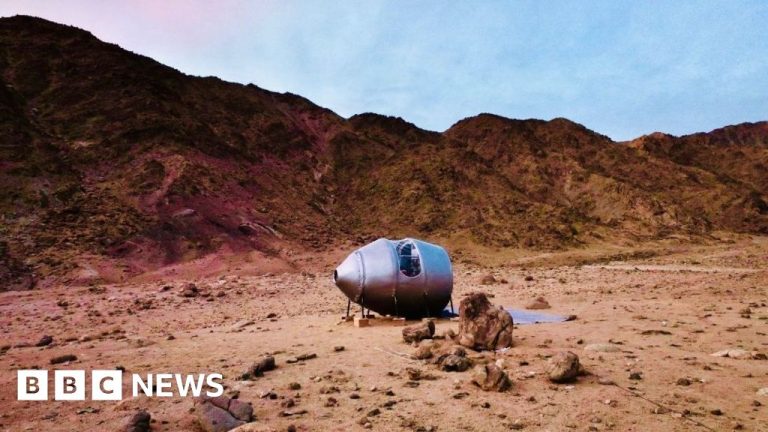AAKA Space Studio
India's first “analogue” space mission Hab-1 tested in the mountains of Ladakh
Could this egg-shaped structure be what Indian astronauts' future home in space will look like?
Hab-1 – short for Habitat-1 – is Indian space agency Isro's first-ever “analog mission”, meaning a simulation of space conditions to prepare astronauts for real space missions. It was recently tested for three weeks in the high Himalayan mountains of Ladakh.
Space architect Aastha Kacha-Jhala, of Gujarat-based Aaka, told the BBC that these simulations help identify and resolve problems that astronauts and equipment might face before space missions.
Constructed of space-grade Teflon and insulated with industrial-grade foam, Hab-1 includes a bed, a pull-out tray that can be removed and used as a workstation, storage space to keep supplies and kits emergency, a kitchenette for reheating meals and a toilet. A simulated astronaut spent three weeks locked in the facility.
“Hab-1 is designed keeping in mind that space will be very limited on the Moon or Mars,” explains Ms Kacha-Jhala. “The astronaut will also have very limited water available, which is why we designed dry toilets. We also put in place a system for proper waste disposal and ensured that the habitat remained odor-free.”
It is currently in talks with Isro to build India's first permanent space simulation facility in Ladakh.
AAKA Space Studio
Space architect Aastha Kacha-Jhala says Hab-1 was designed keeping in mind that space will be limited on the Moon or Mars.
This mission comes as India prepares to send its first astronauts into space.
Isro's Gaganyaan mission plans to place three astronauts in low Earth orbit at an altitude of 400 km (248 miles) for three days. If all goes as planned, the mission will launch next year. India also plans to install its first space station by 2035 and send a man to the Moon by 2040.
NASA, the European Space Agency, Russia, China and other countries as well as private companies with space programs are carrying out dozens of simulation missions and two of the four Indian astronauts selected for the Gaganyaan mission are currently being trained to NASA.
“Once we have our own simulation mission, we will no longer need to depend on foreign space agencies to train our astronauts,” says Professor Subrat Sharma, dean of research studies at the University of Ladakh who collaborated to the project.
Ladakh, he told the BBC, was chosen for the experiment because “geographically, its landscape and rocky, arid soil have similarities to materials and rocks found on Mars.” and parts of the lunar terrain, making it ideal for space research. “.
Soil samples collected during the mission are being tested by the university to see if astronauts will be able to use locally sourced materials to build homes in space.
AAKA Space Studio
Analogue astronaut spent three weeks on India's first analogue space mission
The Himalayan region, on the India-China border, is located at an altitude of 3,500 meters (11,483 feet) and has extreme weather conditions and thin air. In one day, the temperature here can drop from a maximum of 20°C to a minimum of -18°C.
It's not on par with Mars (where temperatures can drop below -153°C) or the Moon (where -250°C is the norm in some deep craters), but it's still a human endurance test. And as Professor Sharma says, “since you can't go into space to test every time, you need facilities where space-like conditions can be created.”
Furthermore, he adds, Ladakh is a region of India where arid lands stretch for miles and miles, “giving you the feeling of being alone on the planet.”
And that's exactly how the simulation astronaut, who spent three weeks confined to the capsule in the freezing desert, felt.
“I was isolated from the human environment. Every movement I made was programmed, when to wake up, what to do, when and when to sleep? A 24/7 camera monitored my every movement and sent data about my activities and my health in the back office,” the 24-year-old, who did not wish to be named, told me.
“The first few days,” he said, “were great, but then it started to feel repetitive and it started to take a toll on me. It started to impact my daily performance. My work schedule Sleep was a bit affected and my concentration deteriorated.”
The simulation astronaut wore biometric devices to monitor his sleep patterns, heart rate and stress levels. His blood and saliva were tested daily to see how he was doing.
Getty Images
Space agencies around the world want to send astronauts to the Moon. This photo shows Buzz Aldrin walking on the Moon in 1969.
Scientists say simulating psychological factors to determine their impact on humans in space is one of the most important parts of the mission.
As space agencies around the world aim to send astronauts to the Moon and establish permanent bases there in the coming years, simulation missions are expected to play a crucial role in research and training.
In April, a team of scientists and engineers began tests in Oregon to prepare NASA's robot dog, Lassie, to walk on the surface of the Moon. In July, four volunteers emerged after spending a year in an “analogue” facility, specially built in Texas to simulate life on Mars.
And according to the Economist magazine, NASA hopes to 3D print a base using only materials found on the surface of the Moon, while China and Russia are collaborating on their own plans.
India does not want to be left behind. Professor Sharma says that once the data collected in Ladakh is analyzed, it “will help us develop medical technology to meet the needs of our astronauts when they face a problem in space.”
“We need to know how our bodies will function on the Moon where the days and nights are much longer than on Earth. Or in space where there is not enough oxygen,” he says.
Follow BBC News India on Instagram, YouTube, Twitter and Facebook.

